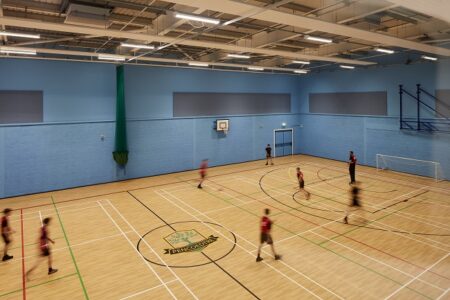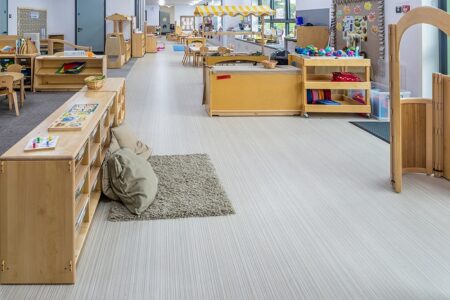Take to the floor!
How flooring manufacturers are responding to the needs of education clients with products for all areas

Flooring is one of the most-extensive surfaces in any school building. Image, Gerflor
The design of buildings is key to ensuring the most-effective and efficient delivery of education services.
And, as floors are one of the most-extensive surfaces in any building, the choice of material and installation and maintenance processes must be carefully considered.
Educational establishments demand attractive, hardwearing, low-maintenance, safe, and sustainable floors in order to create spaces in which people can work, learn, play, relax, and socialise.
Forbo Flooring Systems’ Schools Design Guide – Making Spaces Into Learning Places provides guidance on practical floor cover solutions for primary and secondary mainstream schools.
And it highlights the complexities of choosing the right product for the right area.

Forbo Flooring Systems has produced a design guide to aid specification
Choose wisely
For example, corridors and circulation areas are busy, noisy places and demand durable and safe floor coverings; while technical teaching rooms, such as design, technology, and art classes, often require safety flooring designed with slip resistance and durability in mind.
And while laboratories and science rooms might need flooring which can withstand contaminants, gyms and sports halls benefit from acoustic materials and speciality high-grip surfaces.
A Forbo spokesman said: “Modern-day schools now not only provide spaces to learn and work, but they also offer areas to relax and to socialise in – and the flooring plays a significant role in the total experience.
“In fact, it can help to distinguish different spaces or connect multifunctional spaces together, all the while being functional, decorative, stimulating, or supportive to other architectural elements, depending on the purpose of the space.
“We are constantly working on creating better indoor environments and healthier buildings by supplying floor coverings that are not only functional and comfortable, but also safe and environmentally friendly.”

Budget, aesthetics and acoustics, slip resistance, cleanability, and durability are key drivers when specifying products
Safe and sound
Tony Thorne, specification manager for Wales at Gerflor UK, adds: “Anytime when walking into any room, the floor is a huge part of that environment and should be given the consideration it duly deserves.
“Different stakeholders will have different priorities, but, in general, budget, aesthetics and acoustics, slip resistance, cleanability and durability, along with responsibly-sourced/sustainable solutions are key drivers.
“And, from a pupil perspective, the installation of a floor that is safe for them to interact with, when taking part in sporting activities as an example, is a key consideration for us as a company and something which often gets overlooked or substituted when it comes to design and build projects, unfortunately.”
Gerflor has seen particular interest from education clients in its safety vinyl flooring solutions, which are available in modern, bright, and contemporary designs – making them ideal for schools.
“You can now find safety solutions with authentic wood and stone finishes that are a world away from ‘traditional’ dull grey!”, said Thorne.
“However, safety vinyl flooring can be more difficult to clean than some other flooring products, for example.”
Recent projects which Gerflor has been involved with include providing floor coverings for Pencoedtre High School, a large new-build school in Barry, Wales.
Project designer, HLM Architects, specified 700sq m of Gerflor’s Taraflex vinyl sports flooring in the ‘Maple’ colourway to contrast with the multi-sport markings and sit alongside the sports-recommended blue walls.

Recent projects which Gerflor has been involved with include providing floor coverings for Pencoedtre High School, a large new-build school in Barry, Wales
And the company’s Tarasafe Impression and Tarasafe Standard vinyl safety flooring was installed at a high-end student accommodation development in Gloucester city centre.
Taralay Impression Comfort heterogenous flooring, Creation 55 LVT, and Gradus Boulevard 5000 high-performance Secondary Barrier Matting Tiles, were also used.
Offering advice to specifiers, Thorne has three ‘top tips’:
- Challenge tradition: In a world with constantly-changing technologies and new innovations, it is worth researching into new product developments for building interiors
- Consider who is going to benefit: Is it the main contractor who needs to keep within a budget?Is it the estates manager who has to keep the floor clean and costs low for the next 20 years? Or is it the 12-year-old athlete having to do PE in a hall that is also used for dining? All these competing demands will need to be met
- Talk to flooring manufacturers: They will have solutions for all concerns and for all budgets and timescales. It’s important to just ask!
And, moving forward, he predicts that budgetary restraints and green credentials will underpin future flooring trends.
“It’s no secret that budgets are being squeezed and manufacturers have to adapt to this changing environment by offering cost-effective solutions for all applications,” he said.
“Sustainability is extremely important in flooring manufacturing because it reduces the overall environmental impact that flooring has on our built environment, reducing both the embodied and operational carbon of buildings.
“Sustainable flooring is manufactured using natural, low-carbon, and/or recycled materials, and has a low environmental footprint over the course of its life.”

Flooring must also be sustainable, helping to reduce carbon emissions and futureproofing buildings
Benefits of sustainable flooring include:
- It conserves natural resources and reduces waste by using renewable, recycled, or biodegradable materials, as well as renewable energy during manufacturing processes
- It creates a circular economy where waste materials are used to manufacture new flooring
- It improves indoor air quality and comfort by minimising emissions of volatile organic compounds (VOCs) and allergens
- It improves the longevity of an education facility. With durable and low-maintenance floors, there will reduced energy and water consumption during its lifespan and reduced lifetime CO2 Durable products also require less replacement over the life of a building
